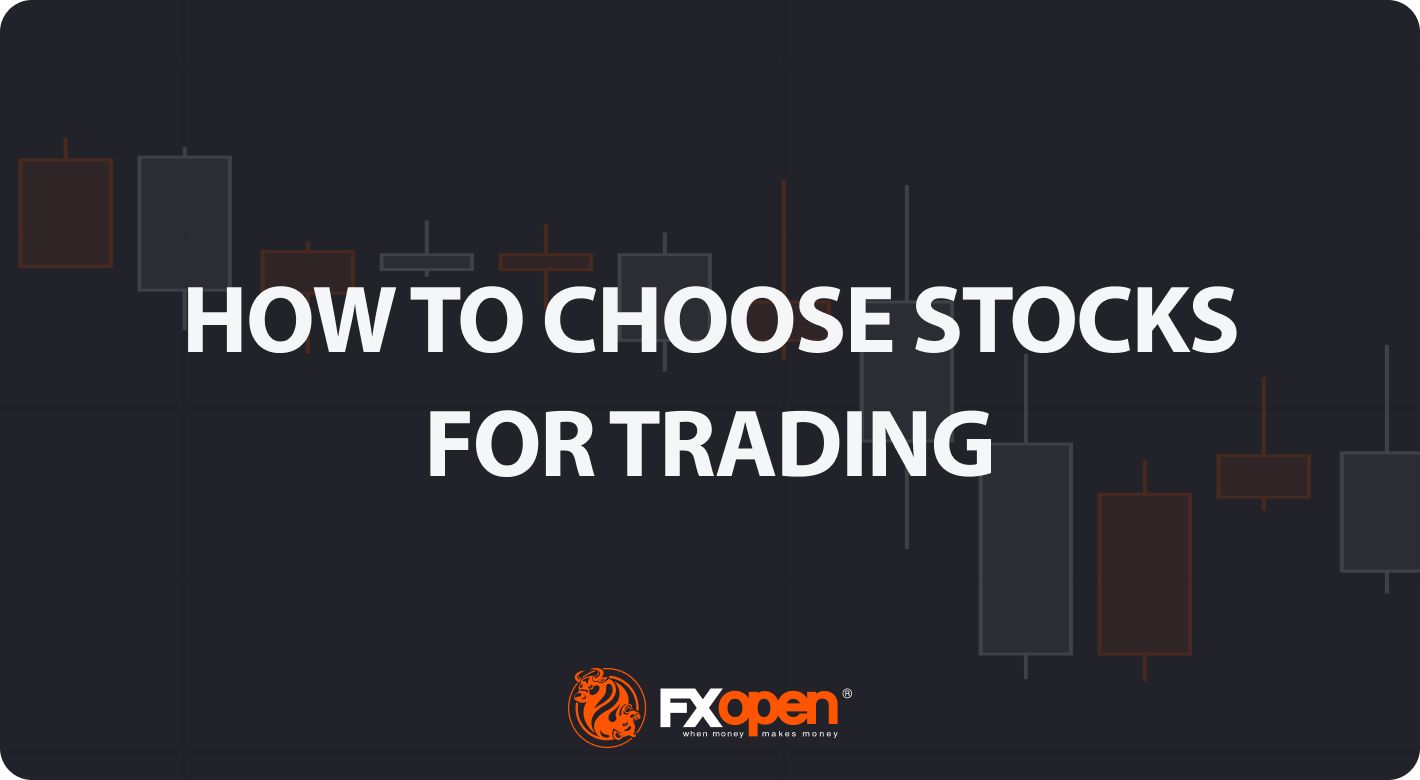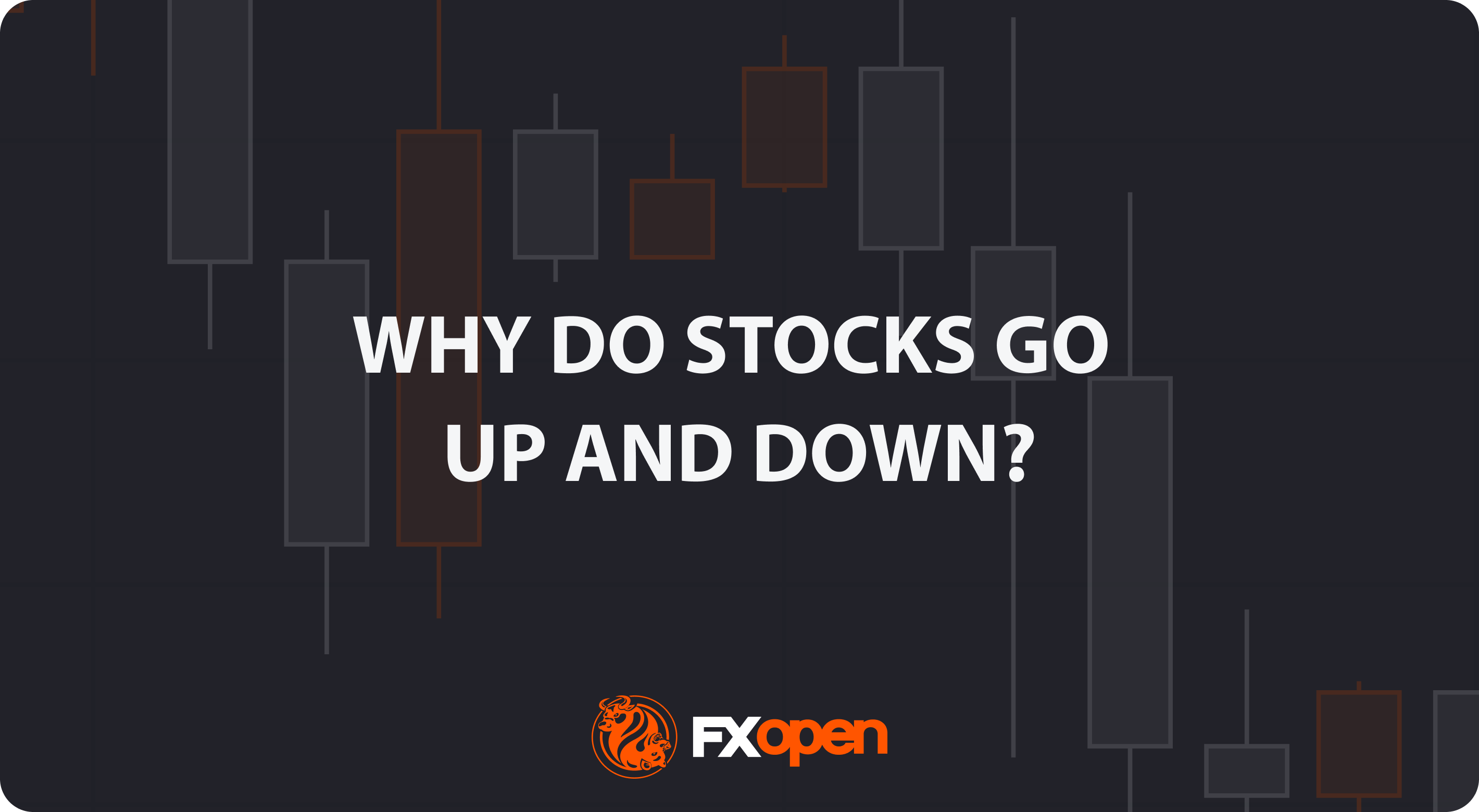FXOpen

What stocks do day traders trade? What stock types are more appropriate for swing traders? Selecting suitable stocks for trading requires an amalgamation of keen market understanding and thorough research. This process, while complex, is fundamental for traders aiming to navigate the ever-evolving financial markets with precision. Platforms like FXOpen provide traders with the tools and resources necessary to facilitate this selection, with instruments like TickTrader aiding in a more refined analysis. This article offers a structured approach to stock selection, encompassing various analytical techniques and considerations.
Understanding Your Trading Goals
Every trader has unique objectives shaping their strategies. While a young trader might aim for aggressive growth, those nearing retirement might focus on capital safety.
Consequently:
- Growth-oriented traders are drawn to emerging companies with promising revenue growth, even if earnings vary, as they provide a high level of volatility.
- Those emphasising capital preservation opt for long-standing firms known for steady profits.
Defining Your Trading Approach
Your trading approach will determine the stocks you can trade:
- Short-Term: This is where understanding how to research stocks for day trading becomes essential. This period, which can last anywhere from a few moments to a few days, is ideal for traders who are looking for rapid market movements. Emerging equities and penny stocks may be an ideal option.
- Medium-Term: Traders who choose medium-term trading lasting anywhere from weeks to months pay attention to securities whose value highly depends on sector trends or company-specific developments that could affect their value in the near future.
- Long-Term: This investment timeframe extends over years. Although it’s not common for traders to keep trades open for such long periods, they may choose stocks with promising growth potential supported by solid company fundamentals.
Are you scouting for the best day trading stocks today, or are you more intrigued by swing trading? With platforms like FXOpen, traders can optimally navigate the markets on chosen timeframes.
Risk Tolerance Assessment
If you are looking for the best stocks for trading, it's crucial to assess the level of risk you're comfortable with in relation to your entire trading capital. Risk tolerance can be categorised into different profiles, such as conservative, moderate, or aggressive:
- Conservative approach: priority for capital preservation and lower-risk investments.
- Moderate approach: a trader may take some risk but still prefer a balanced approach.
- Aggressive approach: higher levels of risk for potentially higher returns.
Understand Stock Types
Stocks can be categorised into various types based on their risk profiles, such as:
- Blue-chips: Generally considered less risky and associated with established financially stable companies.
- Growth: Offers the potential for higher returns but comes with higher volatility and risk.
- Value: Tend to be less volatile and may appeal to more conservative traders.
Fundamental Analysis
Fundamental analysis provides the map for a stock trading journey, using financial statements and key ratios to decode a company's performance and potential.
Evaluating Financial Statements
- Income Statement: This vital document illuminates the revenue, expenses, and profits, acting as a window into a company's profitability over a specific period. By examining it, traders discern how the company generates profits and manages its operating expenses.
- Balance Sheet: Acting as a financial snapshot, the balance sheet reveals a company's assets and liabilities at a particular point in time. It provides insights into the company's net worth and financial resilience.
- Cash Flow Statement: A crucial tool for traders, it traces the journey of cash as it enters and exits the company. More than just profitability, this statement underscores the company's liquidity, showing how well it manages its cash resources.
- Analysing Key Financial Ratios: Ratios like P/E, Debt-to-Equity, and ROE offer profound insights into a company's valuation, leverage, and profitability, respectively.
- Assessing the Company's Industry and Market Position: Understanding the industry trends and the company's standing within its sector provides context. Does the company lead its peers, or does it follow?
- Identifying Potential Catalysts: A product launch, merger, or even macroeconomic factors can serve as catalysts, inducing stock price movements.
Technical Analysis
Technical analysis deciphers stock price movements through historical trends and patterns, enabling traders to base decisions on past data over speculation.
Reading Stock Charts
By analysing chart patterns and technical indicators, you can identify the best stocks with precise entry and exit points, increasing the likelihood of effective trades. For example, if you're looking to learn how to find stocks to day trade, understanding and utilising candlestick patterns can be an incredibly useful tool.
Using Technical Indicators
Technical indicators allow traders to determine the assets with the most promising price movements. Whether you are a day trader or keep trades open for weeks, technical analysis tools will help build a strong trading strategy.
Volume Analysis
Every stock movement is driven by the forces of supply and demand. Volume analysis helps to understand this by shedding light on a stock's trading activity. A surge in volume could indicate a growing interest in a stock, while dwindling volumes could suggest fading enthusiasm. This metric is essential, especially when identifying the best stocks to day trade.
Market Sentiment Analysis
Market sentiment analysis offers a deep dive into traders' collective perceptions, providing insight into their outlook on particular stocks or the market as a whole. Such insights often serve as the vital link between analytical data and the real-world trading environment.
- Understanding Market Sentiment: Recognising the market's overall sentiment can be invaluable. For instance, a predominantly bullish sentiment on a blue-chip stock after a strong earnings report might indicate a potential upward trend.
- Monitoring News and Events: External events, such as an unexpected CEO resignation or geopolitical tensions, can drastically impact stock prices. Staying updated can prepare traders for sudden market shifts.
- Social Media Sentiment Analysis: Platforms like Twitter can be goldmines of trader sentiment. A sudden spike in tweets about a tech company following a product launch, for example, might hint at market excitement.
- Sentiment Indicators and Tools: Several tools, such as those on platforms like TickTrader, offer sentiment metrics. Tracking market volume is a logical way to measure market sentiment. Large market volumes are a good indicator of how the market feels about a particular security.
Screening for Trading Candidates
Traders need a systematic approach to identify the most suitable stocks for their strategy in order to navigate the vast sea of options available. Effective screening can be the difference between capitalising on an opportunity and missing it entirely.
- Liquidity ensures traders can promptly enter or exit trades. Typically, blue-chip stocks have higher liquidity than small-cap stocks.
- Volatility represents price fluctuations. High volatility can provide more short-term trading chances, but it comes with risks. For instance, emerging industry stocks tend to be more volatile.
- Price Trends track stocks with steady trajectories. A stock frequently hitting its 52-week high may suggest a sustained bullish trend.
- Stock Screeners and Tools: With modern tech, traders use stock screeners to filter stocks that match their criteria, streamlining the selection process.
Conclusion
Choosing stocks requires a careful mix of insight, study, and instinct. As markets change, being informed and adaptable remains crucial. Platforms such as TickTrader support traders, providing essential tools for their trading journey. If you are keen to further harness these approaches, consider opening an FXOpen account.
This article represents the opinion of the Companies operating under the FXOpen brand only. It is not to be construed as an offer, solicitation, or recommendation with respect to products and services provided by the Companies operating under the FXOpen brand, nor is it to be considered financial advice.
Stay ahead of the market!
Subscribe now to our mailing list and receive the latest market news and insights delivered directly to your inbox.








